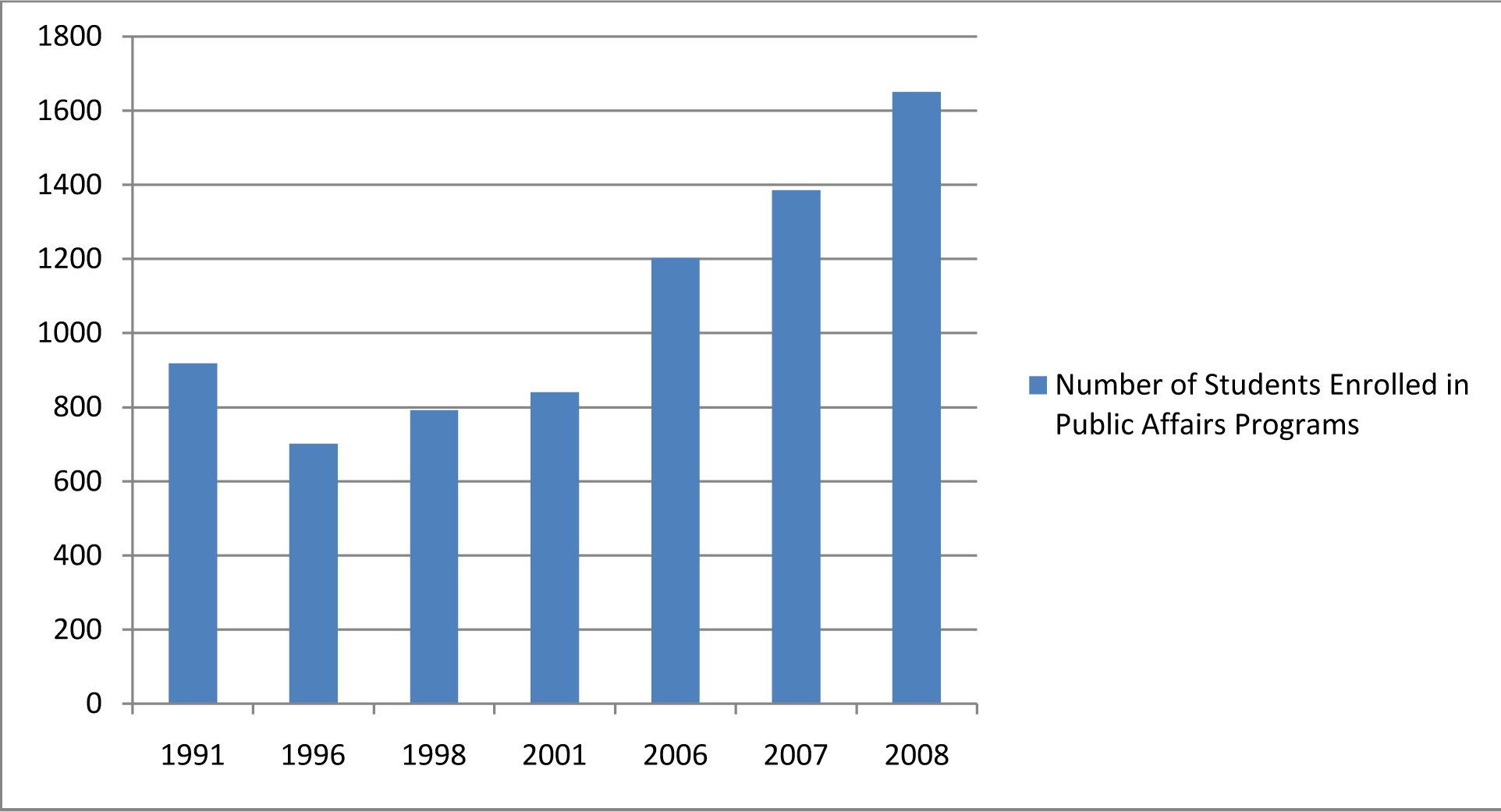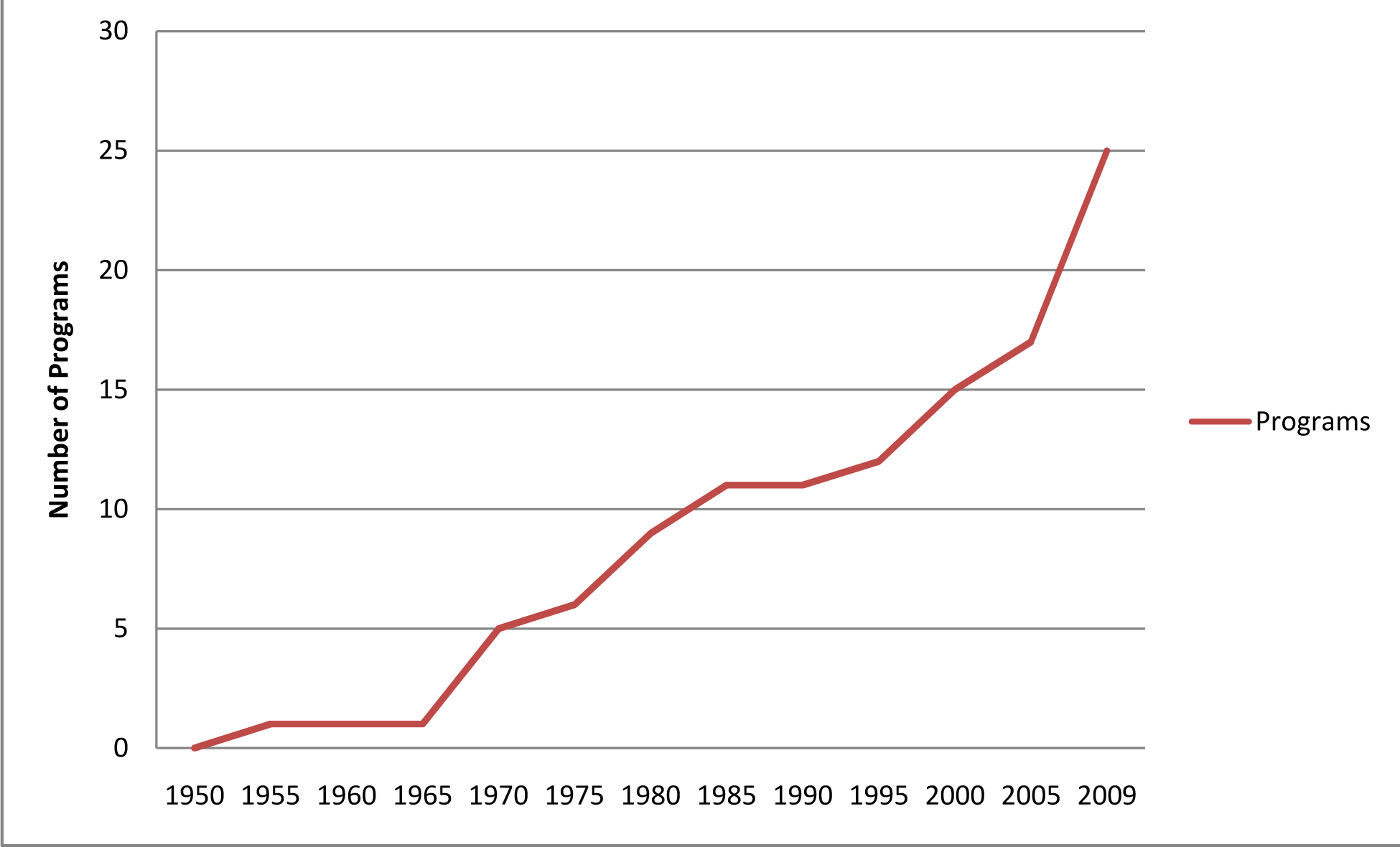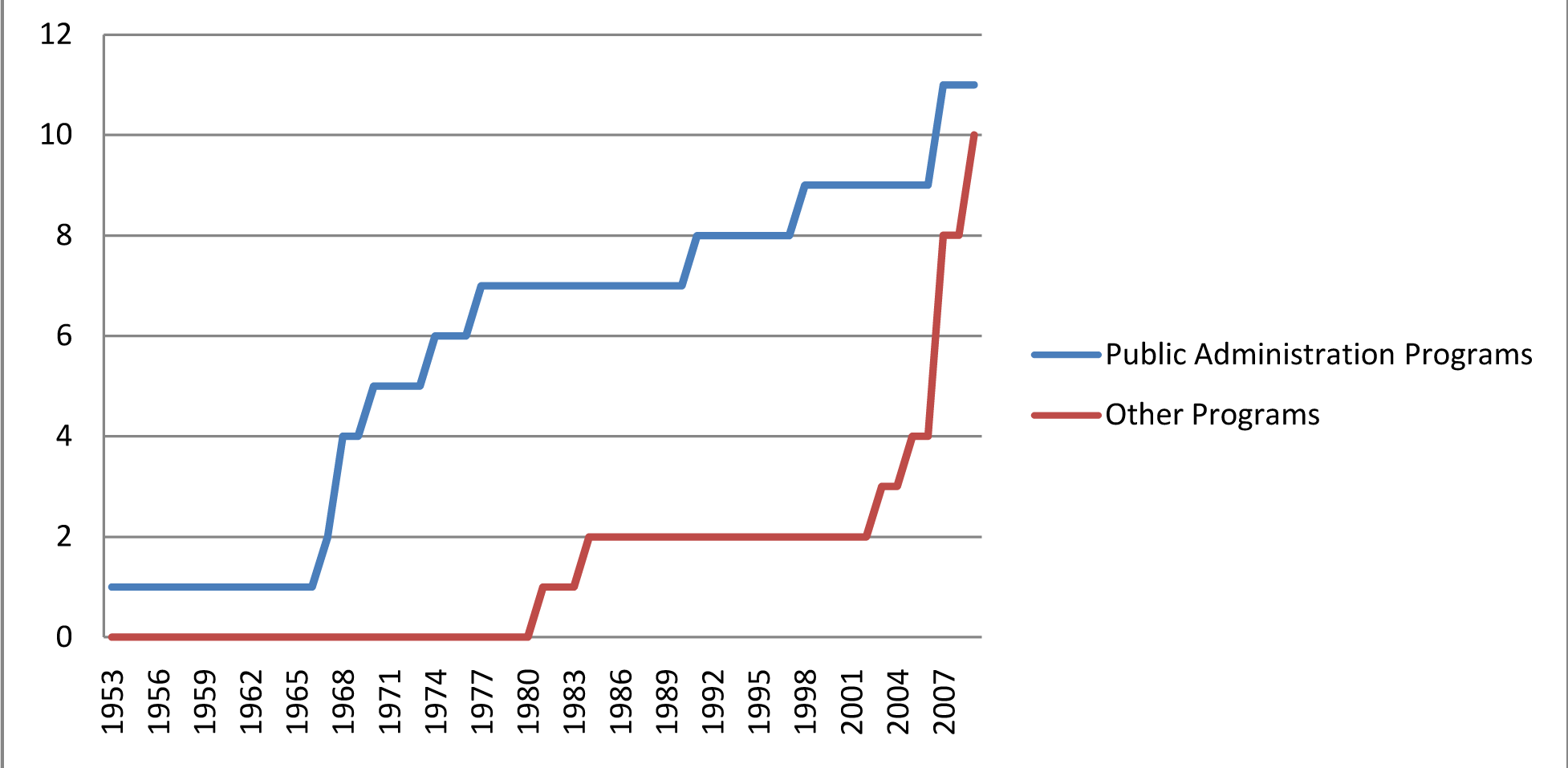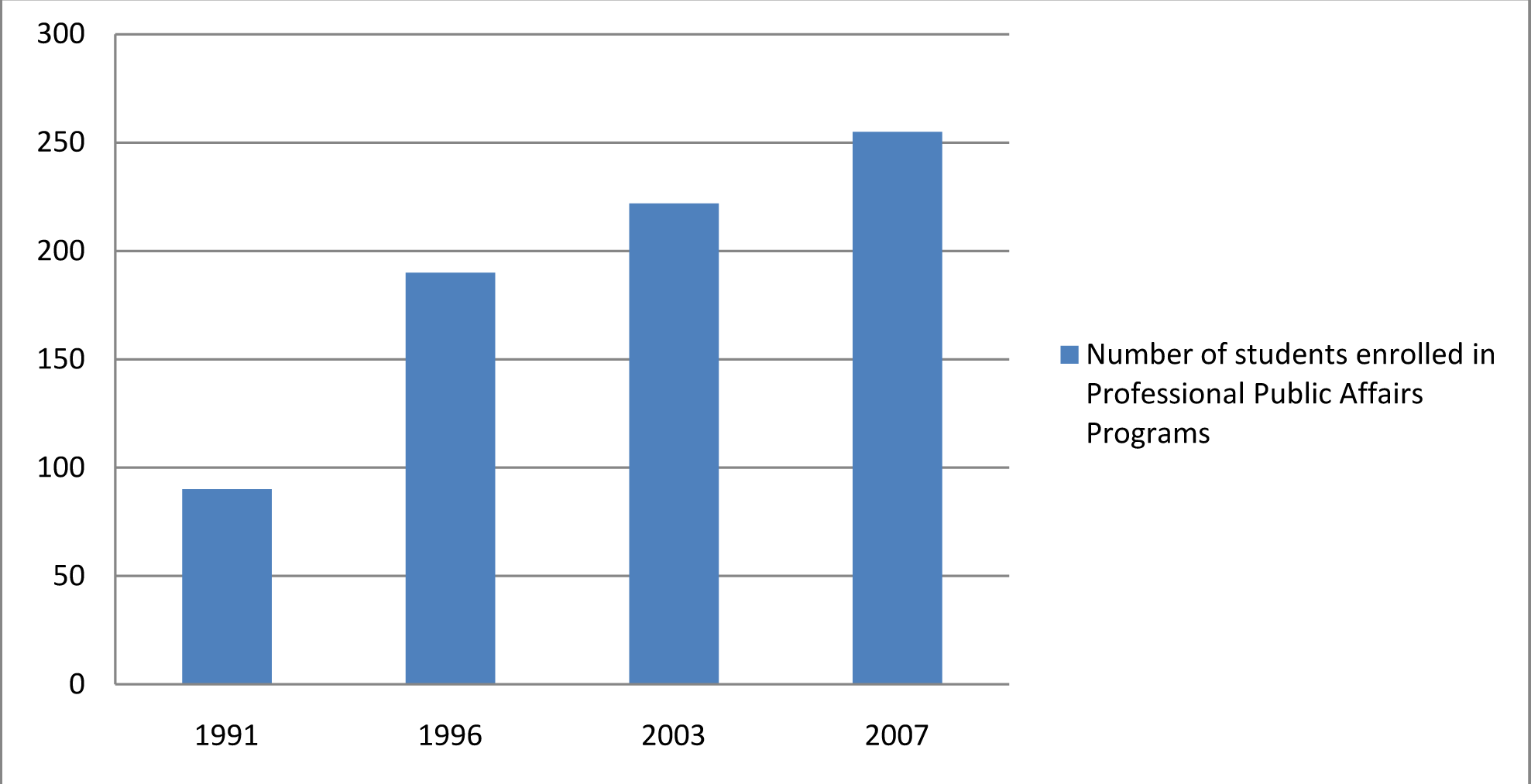 Análisis
Análisis
Transformations in Public Affaires Training in Canada
Por Gerard Boychuk, Michael Middleton, Karolina Werner, Anne Christensen
Programa Formación en asuntos públicos
Cuaderno Formation à la gouvernance
Palabras clave : Canadá ; América del NorteThis paper is based on the analysis of data complied as part of the Canadian component of the World Observatory of Teaching in Public Affairs (WOTPA). The WOTPA is a joint project between the Institute for Research and Debate on Governance (IRG, Paris), the Charles Leopold Mayer Foundation (Paris) and the Swiss Graduate School of Public Administration (IDHEAP, Lausanne); with support from Sciences Po (MPA, Paris), the PolicyNet project at the Centre for International Governance Innovation (CIGI, Waterloo, Canada) and the Balsillie School of International Affairs. The Observatory aims to bring together experiences from around the world, analyze various practices and approaches, and encourage debate on education and public governance.
Contenido
Even a cursory review of public affairs1 training programs in Canada reveals a rich array of programs offered under the auspices of a large number of Canadian universities.2 Public affairs training programs range from traditional public administration and public management, through to new programs specializing in public policy and, most recently, international public policy. Rather than being a product of gradual evolution, this diversity is relatively recent and is the result of significant transformations including: a massive expansion in overall capacity and enrollment; a marked de-concentration of public affairs training beyond a limited number of individual institutions, and a significant broadening of participation by various universities; a shift away from a predominant focus on public administration and public management toward a focus on public policy programs; the internationalization of public affairs programs in terms of content; and a significant expansion in professional programs for in-service public affairs practitioners. The landscape of public affairs training in Canada has been highly dynamic over the past decade and recent developments suggest that it will continue to be so into the foreseeable future.
Snapshot of Public Affairs Training in Canada Circa 2008
Public affairs education in Canada is quite diverse in both the types of degrees offered and the scope of each program. Currently there are 21 public affairs programs operating in Canada offered by 18 different universities. Combined, in 2008, these programs had an overall capacity of over 1,700 students with the eight largest programs accounting for three quarters of this capacity (see Table 1). Of these eight, the majority are well-established programs with a long history in public affairs education, such as at Carleton. The three universities offering large programs which were created in the last decade are Regina, Simon Fraser, and Ryerson.
| School | Degree offered | Students Enrolled in 2008 |
|---|---|---|
| Carleton University | MPA | 147 |
| Concordia University | Master in Public Policy and Public Administration | 100 |
| Dalhousie University | MPA and MPA (Management) | 176 |
| McMaster University | Master in Public Policy and Administration | 15 |
| Queen’s University | MPA and Professional MPA | 222 |
| Ryerson University | MA in Public Policy and Administration | 150 |
| Simon Fraser University | MPP | 150 |
| University of Manitoba/Winnipeg | MPA (joint program) | 59 |
| Université de Moncton | MPA | 12 |
| University of Ottawa | MPA | 76 |
| University of Regina/Saskatchewan | MPA | 172 |
| University of Saskatchewan | Master of International Trade | 20 |
| University of Toronto | Master in Public Policy & Governance | 42 |
| University of Victoria | MPA | 209 |
| University of Western Ontario | MPA | 60 |
| Wilfrid Laurier University | Master in International Public Policy | 18 |
| York University | MPA | 10 |
| York University(Atkinson) | Master of Public Policy, Administration and Law | 85 |
| York University (Glendon) | Master of Public and International Affairs | 18 |
Total number of students enrolled in 2008 : 1741
* In some cases these numbers are based on estimates from previous years
Of the various programs offered, programs in public administration account for nearly half of all public affairs education in Canada. With some notable exceptions, public administration programs are generally designed to provide training appropriate for mid-level positions in the public service; and have structured their curricula accordingly. As such, they are often quite technical and require students to take courses in management, accounting, organizational theory and economics. Many of these programs have strong relations with governmental departments and offer co-op opportunities for students wishing to gain firsthand experience in the public sector.
Outside of this core group, there is a diverse range of programs which include innovative new degrees such as the Master of Public and International Affairs (MPIA) offered by York University’s Glendon School of Public Affairs, the Master of Public Policy and Governance (MPPG) offered by the University of Toronto, and the Master in International Public Policy at Wilfrid Laurier University. These non-MPA degrees represent the newest addition to public
affairs education in Canada. In contrast to more traditional public administration training, many of the newer degree programs have a much broader scope, both in terms of their approach and subject matter. While traditional public administration programs draw upon fields such as business, economics, and political science; many of the newer degrees are even more multidisciplinary, and draw upon environmental science, geography, sociology and development studies. The broad swath of academic disciplines employed by these new programs is matched by their equally broad subject matter. In contrast to the more domestically focused public administration programs, the new programs have expanded their scope to include global and international policy. Newer programs seem less focused on training for the public service. While this remains an objective of these programs, there seems to be equal emphasis placed on preparing students for careers in non-governmental organizations.
In summary, public affairs education in Canada varies from the more traditional public administration programs to public policy, law, and even to international trade. These various programs offer a range of specializations, although there appears to be a greater degree of uniformity within public administration programs than in their more recently developed counterparts. While similar in some ways, there are significant differences between the more traditional, public sector-oriented public administration programs and the newer, broader, more internationally focused programs.
Snapshot of Public Affairs Training in Canada Circa 1998
The snapshot above stands in marked contrast with the situation a decade earlier. In 1998, there were only twelve public affairs programs in Canada,3 the overwhelming majority of which focused explicitly on public administration (see Table 2).4 Four of the eleven public administration programs were located in Ontario, with the remainder distributed across Canada. In general, the MPA programs of 1998 were primarily geared towards preparing students for the public service. Many of these programs, such as the joint program between the University of Manitoba and the University of Winnipeg, offered co-operative education elements designed to prepare students for the professional world. Typically, the course content remained consistent across programs, with students taking courses such as organizational theory, accounting and management.
| School | Degree offered | Students enrolled in 1998 |
|---|---|---|
| Carleton University | Master in Public Administration (MPA) | 185 |
| Concordia University | Master in Public Policy and Public Administration | 130 |
| Dalhousie University | MPA | 99 |
| McMaster University | Master in Public Policy and Administration | 15* |
| University of Manitoba | MPA (joint program with University of Winnipeg) | 20 |
| Université de Moncton | MPA | 18 |
| University of Regina | MPA | 10 |
| University of Western Ontario | MPA | 34 |
| University of Winnipeg | MPA (joint program with University of Manitoba) | 16 |
| University of Victoria | MPA | 153 |
| Queen’s University | MPA | 130 |
| York University | MPA | 11 |
Total number of students enrolled in 1998: 812
* This number is based on estimates from previous years
Whereas public administration degrees were often more technical in nature and focused on preparing public servants, the combined public policy and administration degrees offered by Concordia and McMaster seemed to be broader in terms of their focus and approach, similar to modern specializations offered in 2008. Concordia University, for example, required its students to take courses such as “International Public Policy and Administration”, “Geography and Public Policy” and “Public Policy and Social and Political Theory”. These courses drew upon a variety of disciplines and integrated an international component into the more common, domestically focused public affairs curricula. Similarly the McMaster program differed from other public affairs programs through its emphasis on theory and academia. It is also worth noting that although the Carleton program was formally described as a “public administration” program, students could customize their studies through specializations in “Development” and “Innovation, Science and Environment Policy”. Unlike other MPA programs, which gave preference to applied knowledge, the Carleton program strove to strike a balance between conceptual and technical skills.
Therefore, with few exceptions, public affairs education in Canada in 1998 was dominated by public administration programs which were geared towards public administration training appropriate to mid-level civil service positions. Degree programs were often quite technical and focused on practical skills training. The combined capacity of these programs was relatively small, as fewer than one thousand students were able to enroll in graduate public affairs programs.
Outlining the Trends
These two snapshots highlight the changes that have taken place over the past decade. The following section outlines these trends in more detail.
Expanding Capacity and Broadened University Involvement
Overall, there has been a significant increase in the institutional capacity to offer public affairs training in Canada. However, this trend was not simply the result of expansion of well-established public administration programs. Rather, there has been a proliferation of new programs that have contributed significantly to the increase in overall capacity. The student body has more than doubled since 1998, totaling over 1,700 students in 2008 (see Figure 1).

Figure 1: : Enrollment in Public Affairs Programs, Canada, 1991-2008
As evident in Figure 1, there was a slight decrease in the number of students enrolled in public affairs programs in the mid-1990s, before steadily increasing through to 2008. The temporary decline was caused in part by suspensions and changes in various programs during this time but also by stagnating numbers of students in established programs. Further research is required in order to draw conclusions about the degree to which this stagnation was the result of lowered student demands for traditional MPA degrees.
The marked growth in enrollment which occurred in the decade from 1998 to the present was not simply the result of expansions in established programs but, rather, the result of a proliferation of new programs. In the 1960s, only a select number of universities offered public affairs programs, with Masters in Public Administration mainly available in Ottawa. Throughout the 1970s a few additional degrees were created still primarily in Ontario, with notable exceptions such as the program at the University of Victoria. This was followed by a long period of relative stasis. New programs began to appear in the late 1990s and have continued ever since. Consequently, there has been a substantial increase in the number of public affairs programs offered throughout Canada over the last decade with thirteen new programs created since 2000. (see Figure 2). As outlined more fully below, the majority of these new degrees are interdisciplinary and offer various specializations.

Figure 2 : Public Affairs Programs in Canada, 1950-2009
The sudden surge in graduate degrees in public affairs was, at least in part, driven by Ontario’s 2005 Reaching Higher initiative, in which the Government invested over CAN$6 billion in graduate programs around the province. Correspondingly, the majority of public affairs programs established after 2005 (see the highlighted areas in Table 3) were in Ontario.5 This expansion in capacity resulted in an even more marked geographical concentration of public affairs training. While Ontario comprises just over one third of the Canadian population (and over 40 percent of all university students in Canada), 6 almost half of all public affairs students were attending an Ontario university in 2008. This represents a greater geographical concentration of public affairs training than in 1998, when Ontario students accounted for just over 40 percent of the student body overall. Naturally, Ontario universities have always had a large capacity due to the fact that a large portion of the employers to which these programs cater are in Ottawa. Nevertheless, this geographical concentration has contributed to creating conditions for a counter-trend of expansion in capacity outside central Canada, most notably at the University of Regina, as well as significant planned expansion at the University of Calgary.
| Public Administration Programs | Other Public Affairs Programs | ||||
|---|---|---|---|---|---|
| University | Degree offered | Year established | University | Degree offered | Year established |
| Carleton | MPA | 1953 | Concordia | MPPPA | 1981 |
| York | MPA | 1967 | McMaster | MPPA | 1984 |
| Dalhousie | MPA | 1968 | SFU | MPP | 2003 |
| Winnipeg | MPA | 1968 | Ryerson | MAPPA | 2005 |
| Queens | MPA | 1970 | York (Atkinson) | MPPAL | 2007 |
| Victoria | MPA | 1974 | Saskatchewan | MIT | 2007 |
| Manitoba | MPA | 1977 | Toronto | MPP/MPP&G | 2007 |
| Moncton | MPA | 1978 | Wilfrid Laurier | MIPP | 2007 |
| Western | MPA | 1991 | York (Glendon) | MPIA | 2009 |
| Regina | MPA | 1998 | Calgary | MPP | 2009 |
| Ottawa | MPA | 2007 | Saskatchewan | MPA | 2007 |
The Shift from Administration/Management to Public Policy and Specializations
The large number of new programs has shifted the focus of the overall Canadian system away from a more traditional focus on public administration. The majority of MPAs are currently offered through well-established programs; while more recent MPA programs were created in 1991 at the University of Western Ontario, the University of Regina in 2000, and two additional programs in 2007 at the Universities of Ottawa and Saskatchewan. Even more notable has been the development of a large number of new public affairs-related degrees over the past five years. These new programs offer a broad range of specialties, including: public policy, such as at Simon Fraser University; combinations of public policy and administration; international public policy such as at Wilfrid Laurier University; and public and international affairs, such as at York University. As highlighted in Figure 3, the number of public policy and specialty programs has risen greatly over the last decade; and currently there are nearly as many specialized degrees offered as general public administration degrees.

Figure 3 : Number of Public Affairs Programs in Canada, by program type, 1953-2008
The Internationalization of Public Affairs Training
Programs in public affairs are increasingly offering international content while no longer focusing strictly on national public policy and administration. At least three Canadian programs award degrees that are international in title, and all of them were created in 2007. These include: the Master in International Trade at the School of Public Policy, University of Saskatchewan; the Master in International Public Policy at Wilfrid Laurier University; and the most recent Master in Public and International Affairs at York University.
Furthermore, at least five programs offer specializations in explicitly international subjects, and profess to prepare students for careers in an international setting.7 For example, the University of Toronto’s Masters in Public Policy and Governance does not immediately indicate an international scope however, students are required to take elective courses in two fields of specialization, domestic and global, which are cross-disciplinary. Other programs that offer international specializations include: Carleton, which offers a specialization in International Development; Concordia, with its specialization in International Public Policy and Administration; McMaster, which offers an International Relations concentration; and York, with its International Business stream.
Growth in Professional Programs
Mirroring the expansion in public affairs programs more generally, professional masters programs have expanded significantly over the past decade. While the professional MPA programs at Queen’s (1976) and Dalhousie (1996) provided precedents for this type of program, there has been recent expansion of capacity with three programs coming on-stream after 2003 at the: University of Victoria (2003), University of Saskatchewan (2007) and York University (2007). As of 2009, there are five degree programs which are designed and advertised to complement full time employment, focusing on the public sector in particular. All of these programs deliver content through innovative means such as online interaction and evening or weekend sessions. Notably, the University of Saskatchewan’s MIT and Victoria’s MPA are offered only as an online degree.
Prior to 2003, professional public affairs programs in Canada were focused exclusively on traditional public administration and management. However, of the three new programs founded since 2003, two of them have a non-traditional focus. Specifically, the University of Saskatchewan’s MIT is distinctive in its focus on international trade as is York’s MPPAL which combines an MPA program with a law component. Although there has been a steady increase in professionally geared programs (see Figure 4), they cannot be credited for the increase in the number of students in public affairs overall as they comprise a relatively small portion of enrollment capacity.

Figure 4 : Enrollment in Professional Public Affairs Programs, Canada, 1991-2007.
Further Research
These dynamic changes in the landscape of Canadian public affairs training raise a host of opportunities for further research.
Additional research is needed to identify the degree to which changes in the Canadian and international public service affect shifts in the types and number of programs offered, and influence available curricula and specializations. Currently, there is no formalized mechanism that allows universities to identify the needs of public sector employers and match them by providing graduates with corresponding skills. An overview of how universities establish and measure the success of programs in public affairs, as well as whether employer needs are being met through these programs, would provide important insights into the factors driving program creation and in assessing the effectiveness of public affairs training.
Finally, further research could place developments in Canada within a broader international context in order to determine the degree to which Canada mirrors global trends in public affairs training, versus the degree to which Canadian developments are nationally specific. In addition, international comparisons could provide insights into alternative modes of public affairs training as well as best practices.
Conclusions
The current configuration of public affairs programs in Canada has not been the result of the steady growth of existing programs or a relatively continuous evolution in the focus of public affairs training. Rather, it is the result of a stark transformation over the past decade by which a relatively small number of well-established programs focusing primarily on traditional public administration have been complemented by a new and rapidly expanding layer of programs which, while focusing on public affairs, are much more diverse. This period of dynamic transformation does not yet appear to be over and will likely further accentuate these trends. The outstanding question is whether this new mix of programs will prove effective in meeting the needs of public service employers and other stakeholders.
Notas de pie de página
1 Throughout the paper “public affairs” is used as an internationally recognized, broad term for public administration and management and public policy.
2This study does not include French-only programs within the province of Quebec.
3 Excluding French-only programs in the province of Quebec.
4 Only the McMaster and Concordia University programs differed from their peers by offering Masters in Public Policy and Administration (MPPA) and Public Policy and Public Administration (MPPPA), respectively.
5 Further research would be needed to estimate what percentage of programs created as a result of Government funding were public affairs programs.
6 Statistics Canada, “Table 477-0013 - University enrolments, by registration status, program level, Classification of Instructional Programs, Primary Grouping and sex”, (Ottawa: Government of Canada), 2006
7 Programs were considered to be offering an explicitly internationally specialization when either the bulk of their coursework dealt with international issues or if the title of their degree reflected their international scope.
